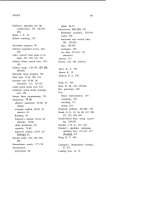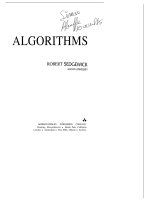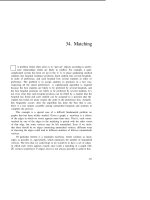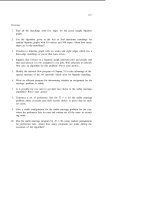Tài liệu Thuật toán Algorithms (Phần 4) pdf
Bạn đang xem bản rút gọn của tài liệu. Xem và tải ngay bản đầy đủ của tài liệu tại đây (148.91 KB, 10 trang )
2. Arithmetic
Algorithms for doing elementary arithmetic operations such as addition,
multiplication, and division have a. very long history, dating back to
the origins of algorithm studies in the work of the Arabic mathematician
al-Khowdrizmi, with roots going even further back to the Greeks and the
Babylonians.
Though the situation is beginning to change, the of many
computer systems is their capability for doing fast, accurate numerical cal-
culations. Computers have built-in capabilities to perform arithmetic on in-
tegers and floating-point representations of real numbers; for example, Pascal
allows numbers to be of type integer or with all of the normal arithmetic
operations defined on both types. Algorithms come into play when the opera-
tions must be performed on more complicated mathematical objects, such as
polynomials or matrices.
In this section, we’ll look at Pascal implementations of some simple
algorithms for addition and multiplication of polynomials and matrices. The
algorithms themselves are well-known and straightforward; we’ll be examining
sophisticated algorithms for these problems in Chapter 4. Our main purpose
in this section is to get used to treating mathematical objects as objects
for manipulation by Pascal programs. This translation from abstract data to
something which can be processed by a computer is fundamental in algorithm
design. We’ll see many examples throughout this book in which a proper
representation can lead to an efficient algorithm and vice versa. In this
chapter, we’ll use two fundamental ways of structuring data, the array and
the linked list. These data structures are used by many of the algorithms in
this book; in later sections we’ll study some more advanced data structures.
Polynomials
Suppose that we wish to write a program that adds two polynomials: we would
23
24
2
like it to perform calculations like
2x + (2 -x) = 3 + x
In general, suppose we wish our program to be able to compute = p(x) +
q(x), where p and are polynomials with N coefficients. The following
program is a straightforward implementation of polynomial addition:
program output);
var array [ of real;
i: integer;
begin
(N)
for i:=O to N-l do
for i:=O to N-l do
for i:=O to N-J do
for i:=O to N-l do
wri
end.
In this program, the polynomial = + is
represented by the array with etc. A polynomial of degree
N-l is defined by N coefficients. The input is assumed to be followed by
the coefficients, followed by the q coefficients. In Pascal, we must decide
ahead of time how large N might get; this program will handle polynomials
up to degree 100. Obviously, should be set to the maximum degree
anticipated. This is inconvenient if the program is to be used at different
times for various sizes from a wide range: many programming environments
allow “dynamic arrays” which, in this case, could be set to the size N. We’ll
see another technique for handling this situation below.
The program above shows that addition is quite trivial once this repre-
sentation for polynomials has been chosen; other operations are also easily
coded. For example, to multiply we can replace the third for loop by
for i:=O to do :=O;
for i:=O to N-l do
for to N-l do
ARITHMETIC
Also, the declaration of has to be changed to twice as
many coefficients for the product. Each of the N coefficients of p is multiplied
by each of the N coefficients of so this is clearly a quadratic algorithm.
An advantage of representing a polynomial by an array containing its
coefficients is that it’s easy to reference any coefficient directly; a disadvantage
is that space may have to be saved for more numbers than necessary. For
example, the program above couldn’t reasonably be used to multiply
even though the input involves only four and the output only three.
An alternate way to represent a is to use a linked list. This
involves storing items in noncontiguous memory locations, with each item
containing the address of the next. The Pascal mechanisms for linked lists are
somewhat more complicated than for arrays. For example, the following pro-
gram computes the sum of two polynomials using a linked list representation
(the bodies of the and add functions and the writelist procedure are
given in the text following):
program output);
type link q =
node = record c: real; next: link end ;
integer; a: link;
function integer) : link;
procedure link);
function q: link) : link;
begin
new(z);
end.
The polynomials are represented by linked lists which are built by the
procedure. The format of these is described in the type statement:
the lists are made up of nodes, each node containing a coefficient and a link
to the next node on the list. If we have a link to the first node on a list, then
we can examine the coefficients in order, by following links. The last node
on each list contains a link to a special node called a: if we reach z
when scanning through a list, we know we’re at the end. (It is possible to get
by without such dummy nodes, but they do make certain manipulations on
the lists somewhat simpler.) The type statement only describes the formats
of the nodes; nodes can be created only when the procedure new is
called. For example, the call new(z) creates a new node, putting a pointer to
26
CHAPTER 2
it in a. (The other nodes on the lists processed by this program are created
in the and add routines.)
The procedure to write out what’s on a list is the simplest. It simply
steps through the list, writing out the value of the coefficient in each node
encountered, until z is found:
procedure link);
begin
while do
begin end;
wri
end
The output of this program will be indistinguishable from that of the
program above which uses the simple array representation.
Building a list involves first calling new to create a node, then filling in
the coefficient, and then linking the node to the end of the partial list built so
far. The following function reads in coefficients, assuming the same format
as before, and constructs the linked list which represents the corresponding
polynomial:
function (N: integer) : link;
var i: integer; link;
begin
for i:=O N-l do
begin end;
end
The dummy node z is used here to hold the link which points to the first node
on the list while the list is being constructed. After this list is built, is set
to link to itself. This ensures that once we reach the end of a list, we stay
there. Another convention which is sometimes convenient, would be to leave z
pointing to the beginning, to provide a way to get from the back to the front.
Finally, the program which adds two polynomials constructs a new list
in a manner similar to readlist, calculating the coefficients for the result
by stepping through the argument lists and adding together corresponding
coefficients:
27
function q: link): link;
var : link ;
begin
repeat
until and
end ;
Employing linked lists in this way, we use only as many nodes as are
required by our program. As gets larger, we simply make more calls on new.
By itself, this might not be reason enough. to use linked lists for this program,
because it does seem quite clumsy to the array implementation
above. For example, it uses twice as much space, since a link must be stored
along with each coefficient. However, as suggested by the example above, we
can take advantage of the possibility that many of the coefficients may be zero.
We can have list nodes represent only the terms of the polynomial by
also including the degree of the term represented within the list node, so that
each list node contains values of c and j to represent It is then convenient
to separate out the function of creating a node and adding it to a list, as
follows:
type link =
node = record c: real; j: integer; next: link end;
function link; c: real; j: integer): link;
begin
end
The function creates a new node, gives it the specified fields, and links
it into a list after node Now the routine can be changed either to
accept the same input format as above (a:nd create list nodes only for
coefficients) or to input the coefficient and exponent directly for terms with
coefficient. Of course, the function also has to be changed
suitably. To make it possible to process the polynomials in an organized









